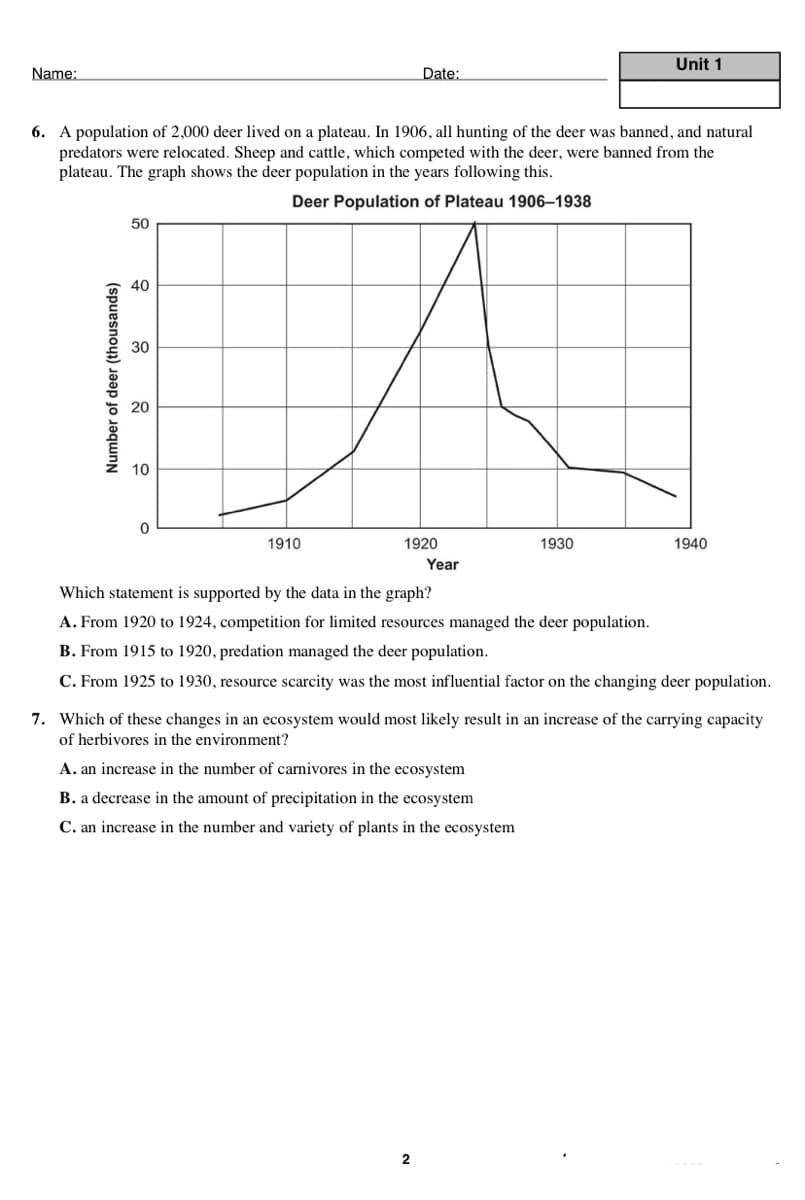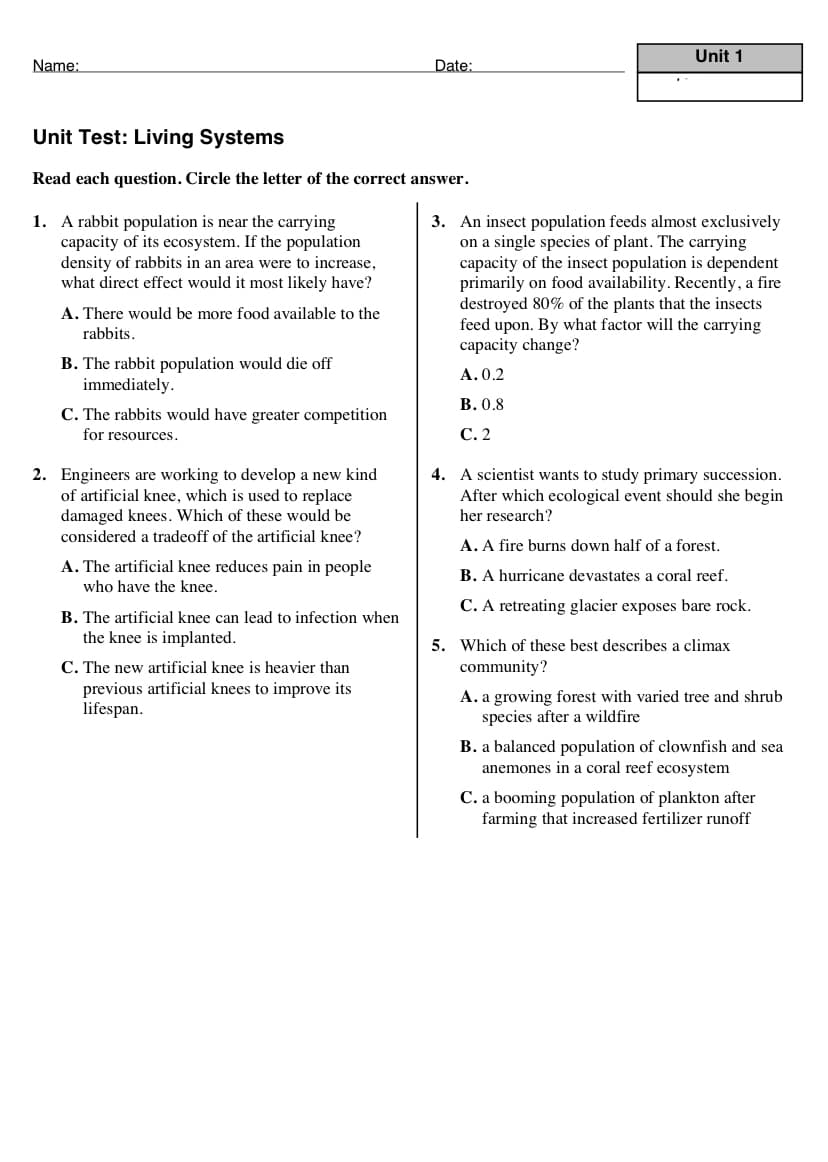6. A population of 2,000 deer lived on a plateau. In 1906, all hunting of the deer was banned, and natural predators were relocated. Sheep and cattle, which competed with the deer, were banned from the plateau. The graph shows the deer population in the years following this. Deer Population of Plateau 1906–1938 50 40 30 20 10 1910 1920 1930 1940 Year Which statement is supported by the data in the graph? A. From 1920 to 1924, competition for limited resources managed the deer population. B. From 1915 to 1920, predation managed the deer population. C. From 1925 to 1930, resource scarcity was the most influential factor on the changing deer population. 7. Which of these changes in an ecosystem would most likely result in an increase of the carrying capacity of herbivores in the environment? A. an increase in the number of camivores in the ecosystem B. a decrease in the amount of precipitation in the ecosystem C. an increase in the number and variety of plants in the ecosystem Number of deer (thousands)
6. A population of 2,000 deer lived on a plateau. In 1906, all hunting of the deer was banned, and natural predators were relocated. Sheep and cattle, which competed with the deer, were banned from the plateau. The graph shows the deer population in the years following this. Deer Population of Plateau 1906–1938 50 40 30 20 10 1910 1920 1930 1940 Year Which statement is supported by the data in the graph? A. From 1920 to 1924, competition for limited resources managed the deer population. B. From 1915 to 1920, predation managed the deer population. C. From 1925 to 1930, resource scarcity was the most influential factor on the changing deer population. 7. Which of these changes in an ecosystem would most likely result in an increase of the carrying capacity of herbivores in the environment? A. an increase in the number of camivores in the ecosystem B. a decrease in the amount of precipitation in the ecosystem C. an increase in the number and variety of plants in the ecosystem Number of deer (thousands)
Biology: The Unity and Diversity of Life (MindTap Course List)
15th Edition
ISBN:9781337408332
Author:Cecie Starr, Ralph Taggart, Christine Evers, Lisa Starr
Publisher:Cecie Starr, Ralph Taggart, Christine Evers, Lisa Starr
Chapter44: Population Ecology
Section: Chapter Questions
Problem 15SQ: Match each term with its most suitable description. _____ carrying capacity a. maximum rate or...
Related questions
Question

Transcribed Image Text:Unit 1
Name:
Date:
6. A population of 2,000 deer lived on a plateau. In 1906, all hunting of the deer was banned, and natural
predators were relocated. Sheep and cattle, which competed with the deer, were banned from the
plateau. The graph shows the deer population in the years following this.
Deer Population of Plateau 1906–1938
50
40
30
20
10
1910
1920
1930
1940
Year
Which statement is supported by the data in the graph?
A. From 1920 to 1924, competition for limited resources managed the deer population.
B. From 1915 to 1920, predation managed the deer population.
C. From 1925 to 1930, resource scarcity was the most influential factor on the changing deer population.
7. Which of these changes in an ecosystem would most likely result in an increase of the carrying capacity
of herbivores in the environment?
A. an increase in the number of carnivores in the ecosystem
B. a decrease in the amount of precipitation in the ecosystem
C. an increase in the number and variety of plants in the ecosystem
2
Number of deer (thousands)

Transcribed Image Text:Unit 1
Name:
Date:
Unit Test: Living Systems
Read each question. Circle the letter of the correct answer.
1. A rabbit population is near the carrying
capacity of its ecosystem. If the population
density of rabbits in an area were to increase,
what direct effect would it most likely have?
3. An insect population feeds almost exclusively
on a single species of plant. The carrying
capacity of the insect population is dependent
primarily on food availability. Recently, a fire
destroyed 80% of the plants that the insects
feed upon. By what factor will the carrying
capacity change?
A. There would be more food available to the
rabbits.
B. The rabbit population would die off
immediately.
А.0.2
В. 0.8
C. The rabbits would have greater competition
for resources.
С.2
2. Engineers are working to develop a new kind
of artificial knee, which is used to replace
damaged knees. Which of these would be
4. A scientist wants to study primary succession.
After which ecological event should she begin
her research?
considered a tradeoff of the artificial knee?
A. A fire burns down half of a forest.
A. The artificial knee reduces pain in people
B. A hurricane devastates a coral reef.
who have the knee.
C. A retreating glacier exposes bare rock.
B. The artificial knee can lead to infection when
the knee is implanted.
5. Which of these best describes a climax
C. The new artificial knee is heavier than
previous artificial knees to improve its
lifespan.
community?
A. a growing forest with varied tree and shrub
species after a wildfire
B. a balanced population of clownfish and sea
anemones in a coral reef ecosystem
C. a booming population of plankton after
farming that increased fertilizer runoff
Expert Solution
This question has been solved!
Explore an expertly crafted, step-by-step solution for a thorough understanding of key concepts.
This is a popular solution!
Trending now
This is a popular solution!
Step by step
Solved in 2 steps

Knowledge Booster
Learn more about
Need a deep-dive on the concept behind this application? Look no further. Learn more about this topic, biology and related others by exploring similar questions and additional content below.Recommended textbooks for you

Biology: The Unity and Diversity of Life (MindTap…
Biology
ISBN:
9781337408332
Author:
Cecie Starr, Ralph Taggart, Christine Evers, Lisa Starr
Publisher:
Cengage Learning

Biology: The Unity and Diversity of Life (MindTap…
Biology
ISBN:
9781305073951
Author:
Cecie Starr, Ralph Taggart, Christine Evers, Lisa Starr
Publisher:
Cengage Learning


Biology: The Unity and Diversity of Life (MindTap…
Biology
ISBN:
9781337408332
Author:
Cecie Starr, Ralph Taggart, Christine Evers, Lisa Starr
Publisher:
Cengage Learning

Biology: The Unity and Diversity of Life (MindTap…
Biology
ISBN:
9781305073951
Author:
Cecie Starr, Ralph Taggart, Christine Evers, Lisa Starr
Publisher:
Cengage Learning


Human Biology (MindTap Course List)
Biology
ISBN:
9781305112100
Author:
Cecie Starr, Beverly McMillan
Publisher:
Cengage Learning

Case Studies In Health Information Management
Biology
ISBN:
9781337676908
Author:
SCHNERING
Publisher:
Cengage